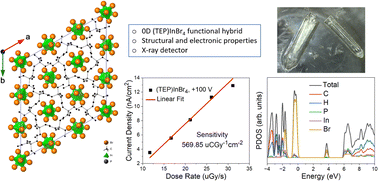Crystal growth, structural and electronic characterizations of zero-dimensional metal halide (TEP)InBr4 single crystals for X-ray detection†
Abstract
Recently, metal halides have shown great potential for applications such as solar energy harvesting, light emission, and ionizing radiation detection. In this work, we report the preparation, structural, thermal, and electronic properties of a new zero-dimensional (0D) halide (TEP)InBr4 (where TEP is tetraethylphosphonium organic cation, C8H20P+). (TEP)InBr4 single crystals are obtained within a few days of continuous crystal growth time via a solution growth methodology. (TEP)InBr4 shows a relatively large optical bandgap energy of 4.32 eV and a low thermal conductivity between 0.33 ± 0.05 and 0.45 ± 0.07 W m−1 K−1. Based on the density functional theory (DFT) calculations, the highest occupied molecular orbitals (HOMOs) of (TEP)InBr4 are dominated by the Br states, while the lowest unoccupied molecular orbitals (LUMOs) are constituted by both In and Br states. (TEP)InBr4 single crystals exhibit a semiconductor resistivity of 1.73 × 1013 Ω cm and a mobility-lifetime (mu-tau) product of 2.07 × 10−5 cm2 V−1. Finally, a prototype (TEP)InBr4 single crystal-based X-ray detector with a detection sensitivity of 569.85 μC Gy−1 cm−2 (at electrical field E = 100 V mm−1) was fabricated, indicating the potential use of (TEP)InBr4 for radiation detection applications.



 Please wait while we load your content...
Please wait while we load your content...